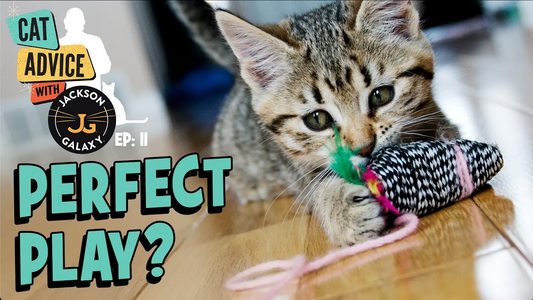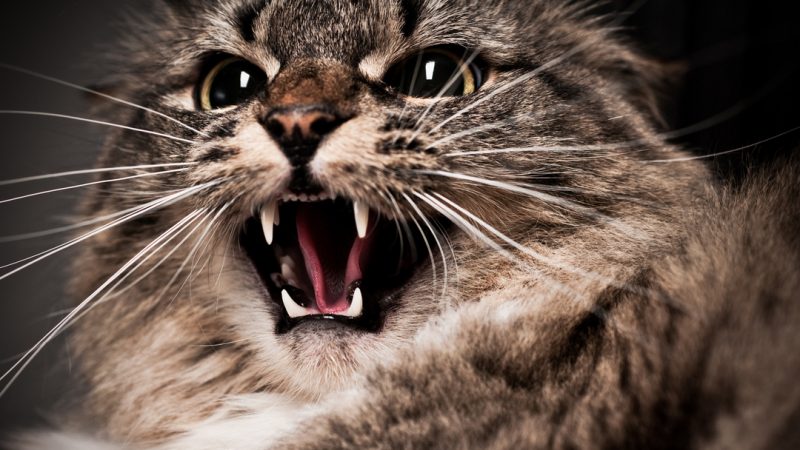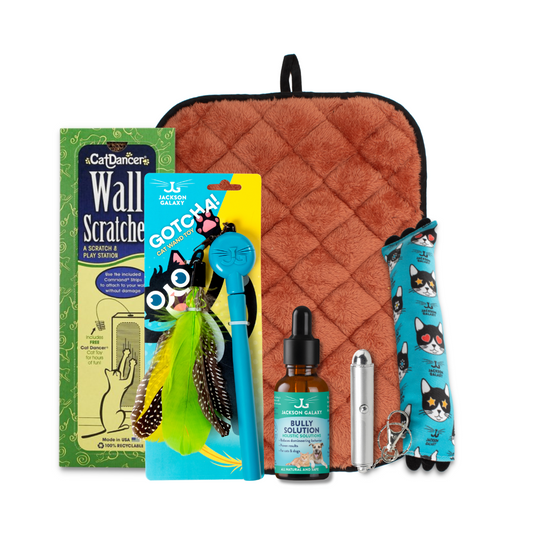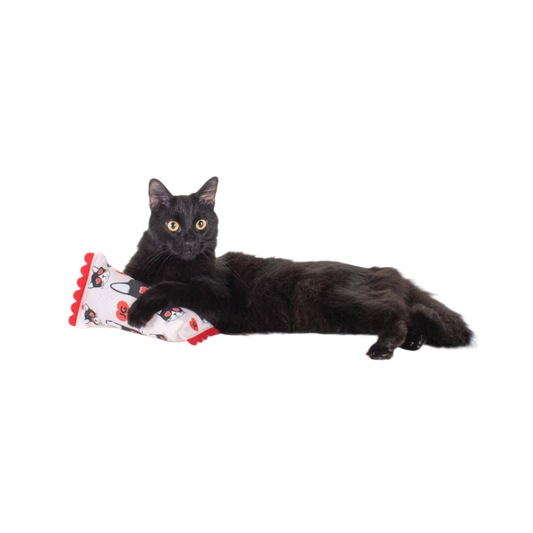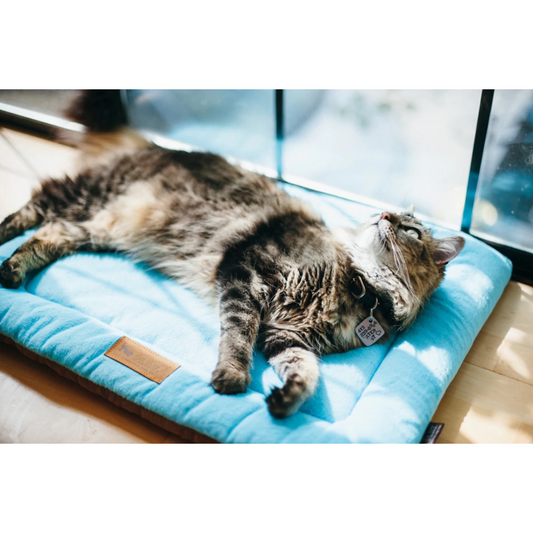Is your cat biting and/or attacking you or other people? Aggression in cats is not uncommon, but it’s unusual for it to be serious enough for people to seek professional help. Follow along as we lay out the different types of aggressions your cat could be experiencing and the ways to calm them. This is absolutely treatable; but to do it right may take considerable time and effort.
With cat-to-human aggression, the roots almost always lie with the person. Cats who, as kittens, were played with or handled roughly by one or more people, and people who don’t understand cat behavior and unwittingly encourage aggressive behavior, are most often to blame. Jackson has featured many such people on My Cat From Hell. However, pain and other medical conditions can also trigger aggression, so don’t neglect that all-important check-up!
Indoor enrichment to help stave off boredom and expand territory is a good first step (See Jackson’s post on catification).
Cats are both predators and prey; in multi-cat homes they have a social hierarchy; and they are very territorial. Understanding these instincts will help you see the world through your cat’s eyes, and understand why certain situations elicit certain aggressive reactions. While serious aggression can and should be treated by a professional.
If your cat starts to show signs of aggressive behavior it’s important to stay calm and collected. Avoid any large reactions—such as screaming, yelling, or pushing your cat away—as this will certainly escalate things.
The physical signs of aggression include:
The Tail
- Tail Twitching: If your cat’s tail is moving back and forth, she could be trying to assess the situation, or it could indicate that she is agitated.
- Tail Bristled: This is a big warning sign that your cat is angry about something. She’s making herself look larger and scarier in order to ward off the perceived threat.
The Ears
- Ears Back: Ears back could indicate that your cat is feeling nervous, anxious, or even irritated.
- Ears Flat: Ears flat against the head signal an angry or aggressive cat who is feeling scared and defensive.
The Whiskers
- Whiskers Flattened: When your cat’s whiskers are held back and flat against her face, she is likely feeling afraid or defensive.
- Whiskers Forward: Whiskers pointing forward mean your cat is investigating something. It may also be an indication that she is about to bite whatever is in front of her.
Now to the signs we can’t see. Below is a list of the most common behavioral patterns when it comes to aggressive actions and our suggested solutions.
PLAY/PREDATORY AGGRESSION
Play/Predatory aggression in cats involves their normal hunting and killing behaviors.
In many cats, their play becomes too aggressive because their human companions encouraged that behavior when they were kittens. Rough-housing with bare hands is almost irresistible when kittens are small. Everyone loved that video of the “surprised kitten” on YouTube – who wouldn’t? Unfortunately, though, that’s a good way to teach a kitty that bare hands are (a) threatening, and (b) okay to play with. It’s adorable when they’re little, but when the attacker is 15 pounds with inch-long fangs…not so much! For many adult cats who still play inappropriately, or turn their predatory drive on humans or other animals in the home, the underlying problem is usually boredom and excess energy. Cats who are especially territorial may be also more prone to predatory aggression. To correct the problem, never play rough with your cat, but more importantly, institute regular sessions of Play Therapy.
PETTING-RELATED (OVERSTIMULATION) AGGRESSION
Petting-related (overstimulation) aggression is frustrating and frightening. One minute you’re having a cuddly moment with your sweet furball, and the next minute the cat is going in seven directions at once, and you’re left bleeding from multiple bites or scratches. Cats are highly sensitive creatures, and it may be that there’s just so much stimulation the cat can take; or there are certain “off-limits” areas that are certain to draw blood–from you–if you stray too close. There may be a pain issue, or a bad memory, but whatever the reason, very few cats attack without warning, though it may seem that way. It’s important to become an expert in feline body language.
Widening or “blackening” of the eyes (dilated pupils), ears turned or laid back, twitching tail, whiskers flattening against the face; these are all signs of impending doom. The trick is to STOP before the cat feels it necessary to take the next step. Never try to restrain the cat! Gently remove all of your vulnerable body parts from the vicinity; or if that’s not possible, try using distraction to shift the kitty’s attention to something that can’t be hurt, such as a toy, throw pillow, or rolled-up socks. Be sure to leave such items in strategic locations around the house so there’s always one handy. And, of course, Play Therapy will help diffuse some of the stress and anxiety that may be contributing to the cat’s sensitivity.
REDIRECTED AGGRESSION
You might find yourself asking, “Why does my cat bite me unprovoked?” Well, redirected aggression occurs when the cat becomes frightened or upset, but rather than run or go after the real cause, the cat instead turns on the handiest target. Often this innocent victim is another cat or pet in the home, or the guardian. Thereafter, the mere sight of the victim brings up all that upset all over again, and the cat continues to attack unprovoked. . If the issue is between two cats, the best course of action in this case is complete separation followed by gradual reintroduction, as if the two had never met. Of course, if you’re looking to stop your cat from biting or attacking you, Play Therapy will also help. It gives the aggressor an acceptable outlet for her frustration, and it restores the victim’s confidence.
FEAR-INDUCED AGGRESSION
Fear-induced aggression is something all veterinarians are very familiar with; it’s something we just hate to see come through that door! Fear aggressive cats operate on the theory that “the best defense is a good offense.” These cats can get pretty offensive! But fear aggression can occur in any situation where the cat feels both threatened and trapped.
The sympathetic nervous system kicks in with the “fight or flight” reflex; if there’s nowhere to flee, the only option is to fight. A fear-aggressive cat is extremely fearsome in itself; this is a cat that can hurt you, badly. Be very careful! Once again (you’re getting the idea, aren’t you?) Play Therapy will help with the cat’s overall level of anxiety, not to mention wear him out!
INTACT CAT AGGRESSION
Intact cat aggression includes
both maternal aggression (totally normal behavior in a new mother when defending her kittens), and territorial tomcat aggression. Intact cats, both male and female, tend to be more aggressive as well as highly territorial; and they are also apt to spray urine on any and all convenient surfaces. The solution: spay/neuter, of course!
POD-CAT AGGRESSION
Pod-cat aggression occurs when one cat has been out of the house, whether to the veterinarian, groomer, or other destination, and when he returns home, the other cat(s) act aggressively toward him. My theory is that, while cats rely primarily on vision to identify other cats, smell also plays a big role. When the returning cat looks the same but smells different (from shampoo, anesthesia, etc.), the conflict creates suspicion that he’s an alien, and must be driven out. (If you don’t get the reference, see the classic movie, Invasion of the Body Snatchers!) People also report success putting a drop of vanilla extract on all the cats; I haven’t tried it, but lots of folks swear by it. Temporary separation may solve the problem; but occasionally there needs to be a complete reintroduction.
Feline aggression is no joke, especially if it’s threatening the cat’s home–or life. It’s a lot easier to fix a problem early than after the behavior has become entrenched. Don’t just “put up with it” until you snap. That’s not fair to anyone! Regular Play Therapy will prevent many behavior problems from developing in the first place, so establish that routine as soon as your new cat enters the household (though it’s never too late to start!). And no matter what, please do not even consider declawing as a solution; experts believe that declawing tends to make an aggressive cat more aggressive; and a cat bite is much more serious than a scratch.
You can also try Flower essences (You can view the full Flower Essence line here). They help the cat assess problem situations a little more rationally, by dissipating the cloud of rage or terror that cats can generate in a nanosecond. In extreme cases, a trial of medication may be needed while other behavioral methods are introduced.
Don’t forget to read Jackson’s post on play therapy!
This post is by Dr. Jean Hofve, DVM, holistic veterinarian and original founder of Spirit Essences holistic solutions for animals (now known as Jackson Galaxy Solutions for Animals), which Jackson uses regularly to help resolve the problems seen on My Cat From Hell.
Hint: For more related topics, see



